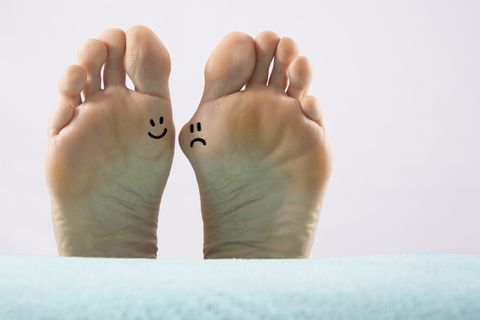A bunion is a deformation of the foot. This is a biomechanical imbalance of the foot when the first metatarsal bone is displaced due to alignment. The metatarsal bone is located behind the big toe. The statement that the bunion is a bone that is growing on the inside of your foot is wrong because it only looks like this. The fact is that it is the displacement of this bone.
Is it a common condition?
The possibility of developing bunions raises with age but approximately one in four people before the age of 65 get a bunion. And over the age of 65, more than one in three people suffer from them. This is partly due to genetics, but women are more prone to have bunions because of wearing high heels. Such shoes create an imbalance in your foot that pushes the metatarsal bone inside.
How to recognize a bunion?
You can notice that you have a bunion when you compare your feet with other people’s feet and see a bump on the inside part of the foot near the big toe joint. The main symptoms are:
- Pain
- Inflammation
- Redness
- Tenderness
- Stiffness in the joint
Early intervention is the best way out. Bunions get worse when you neglect them. The treatment depends on your level of pain. If your pain is not very severe and you want to get rid of bunions, you can try some conservative non-surgical treatments.
What about surgery?
All non-surgical methods of treatment are aimed to eliminate the symptoms. But as soon as the bone is displaced, you can do nothing to move it back, except for bunion surgery nyc.
The following corrections can reduce discomfort, cure inflammation and relieve the irritation of soft tissues. Try these tips for a few weeks in order to see if there are any improvements:
Choose an appropriate time for buying shoes
If you are going to buy a new pair of shoes, it is better to try them on in the evening when your feet will become the plumpest because they gradually swell during the day. It will guarantee that the shoes are comfortable and won’t press on the bunion. If you still feel pinching in some places, gel pads can help.
Avoid high heels
Perhaps high heels were the trigger to this condition. Wearing them is not a very healthy decision for your feet but will also aggravate the bunion’s development. Heals can make a mild bunion more severe. It is also better to avoid the tendency to wear shoes without socks whenever possible.
Pay attention to the arch support
People with flat feet are more likely to get bunions. Arch inserts or shoes that have arch support can help. If you need a custom orthotic, you can ask your podiatrist about options. Orthopedic shoes can’t cure bunions but they make your feet feel comfortable which slows down their development.
A bunion splint is an option
Bunion splints (they are also called big-toe straighteners) can be found in almost every drugstore. But they are not able to completely cure bunions. They can align the bone a little but this is a temporary achievement. The splints are able to make muscles and soft tissues feel more comfortable, but the bunion will reappear once you remove them.

